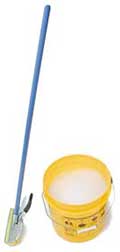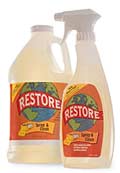 |
Cleaners

The chemicals in cleaning products can be hazardous to
maintenance workers and building occupants. These products can also
be costly to store and dispose of. Products that are safer for human
users are generally safer for the environment as well, and can
replace more-toxic products.
Environmentally preferable cleaners may not be as readily
available, but they are generally competitively priced. This
includes the purchase price of the product, the cost of meeting
regulations for worker safety and environmental rules, and the costs
of disposal for leftover product.
To better safeguard the health of custodial workers, building
occupants, and the environment, the state of Minnesota added
environmental specifications to the state cleaning supplies
contract.
|
 |
![]() |
 |
Minnesota
State Contract
Minnesota
Central Stores
Success Stories
 City
of St. Paul City
of St. Paul
 University of Minnesota University of Minnesota
Other
Resources
|
Minnesota State Contract for Cleaning Products
When products were reviewed for the current state contract for
cleaners, vendors were asked for the first time to include
information about the environmental performance of their cleaning
products. All products selected for the state contract — 33
categories of cleaning products, including all-purpose cleaners,
cleaners for toilet bowls, furniture and glass, deodorizers,
disinfectants, soaps and floor cleaners— were screened and rated for
cleaning performance and environmental characteristics. This
approach screened out many of the more harmful products, while still
providing a variety of products from which to choose.
-
The environmental review addressed human safety first. Vendors
received higher points for avoiding product ingredients that are
highly toxic, cancer-causing, flammable, or prone to cause skin
irritation, respiratory problems or allergic reactions.
-
The evaluation also addressed potential environmental impacts
because chemicals in cleaning products end up in local wastewater
systems, and eventually can pollute our rivers and lakes.
-
Products received higher points for using plant-based
ingredients because they are a renewable resource. Points were
awarded for avoiding phosphates and substances that contribute to
ozone depletion.
-
Preference was given to products sold in reusable and/or
recycled content packaging. A few points were also given to
products not sold in aerosol containers because punctured or
half-empty aerosols can increase flammability.
-
Products with synthetic dyes and fragrances were avoided to
limit potential allergic reactions or skin
irritations.
|
|
Minnesota's Central Stores: Greener cleaner available
Central Stores carries Spray & Clean, a pH-neutral,
plant-derived, water-based cleaner. This less-toxic cleaner — one of
the products on the state contract — replaces corrosive, caustic and
butyl-based cleaners that can irritate lungs, skin and eyes.
As a spray and wipe cleaner, Spray & Clean can be used on
desks, file cabinets, computer monitors, fax machines and copiers,
walls, tile & grout, porcelain, stainless steel. laminates and
any hard surface.
Spray & Clean is available in an 18oz. ready-to-use spray
bottle and a 64oz. refill size to save on packaging.
Restore Spray and Clean is made of plant-based surfactants, and
includes no petroleum-derived ingredients. The pH-neutral formula is
designed to be safer for the user and the environment and can be
safely disposed of in septic systems. Spray & Clean contains no
bleach, alcohol, ammonia, phosphates, petroleum distillates or
fuming solvents; as a result, it emits no noxious fumes or volatile
organic chemicals (VOCs).
Spray & Clean is supplied by Restore
Products, a division of Brown & Company, LLC
(St. Paul, Minn.).
|
 Order Spray & Clean from Central
Stores using these stock numbers. Order Spray & Clean from Central
Stores using these stock numbers.
|
9301
|
18oz. pump-spray bottle
|
9302
|
64oz. refill
| |
Success Story: City of St. Paul
"Overall, the non-toxic cleaners that we used in the last four
months produced sparkling clean results and our custodial staff
experienced fewer physical reactions when applying cleaning
products," said Mark Galloway, building superintendent of the St.
Paul City Hall Annex. "I'm particularly impressed with the
performance of the new degreaser in removing deep stains and the
furniture cleaner's effectiveness in repelling fingerprints and
smudges from elevators and lobby furniture."
Responses similar to Galloway's were gathered in a pilot project
that tested the performance of ten non-toxic cleaning products on
typical office building surfaces such as glass, toilets, sinks,
walls, floors, and furniture. Funded through a grant from the OEA,
the Neighborhood Energy Consortium and the City of St. Paul
organized this pilot in the spring of 1997. 
The 65-year old downtown St. Paul building served as an ideal
location, with 17 floors, approximately 350 workers, and a link to
the heavily traveled public skyway system. Under these conditions,
products must perform well. The custodial staff of the city hall
annex found that six of the ten alternative products worked as well
as, or better than, the products they replaced. Moreover, custodial
staff specifically noticed a reduction in the fumes that sometimes
cause physical reactions such as lightheaded sensations and
tightening of the chest. Overall, the non-toxic products were also
price-comparative with the cleaners they replaced.
Restore the Earth (now known as Brown & Company) supplied the
non-toxic cleaners for the pilot project. The cleaning products
selected were derived from plant matter and renewable resources.
They specifically avoided products containing hazardous chemical
ingredients, chlorinated substances, phosphates, volatile organic
compounds, and petroleum solvents or propellants. Products were also
provided in refillable, reusable containers.
As a result of the pilot's success, the city hall annex custodial
staff plans to continue using most of the products tested.
|
St. Paul
Neighborhood Energy Consortium (NEC)
624 Selby
Avenue
St. Paul, MN
55104
651-222-7678
| |
Success Story: University of Minnesota
In the fall of 1999, the University of Minnesota's Facilities
Management Division realized that empty and partly filled cleaning
product containers were piling up in janitors' closets. With
11 million square feet being cleaned every day, the container
pile-up was not just a logistical disposal problem — it was an
employee health threat.
Environmental Health Specialist Clayton Handt and his colleagues
set up a review board to do a top-to-bottom evaluation of the
division's cleaners. The board discovered that Facilities Management
was buying nearly 500 different products, many of which were
redundant and contained chemicals listed on the U.S. EPA's Toxic
Release Inventory (TRI).
After a thorough review, 70 percent of the division's inventory
was eliminated. The board also agreed to switch to plant-based
cleaners by 2005. source:
Institute for Local Self-Reliance
|
University
of Minnesota
Marshall Skule, Facilities Manager of
CLA District, 612-626-7560
| |
|
|
Other information sources for cleaners
- Janitorial
Products Pollution Prevention Project
This is a project summary for two projects conducted during
1998-99 in the San Francisco Bay Area. The first project, which
took place in the City of Richmond, focused upon the needs of
small organizations; the second was hosted by the county of Santa
Clara, emphasizing large organizations. In addition to project
details, the site includes fact sheets, tools for evaluating
products, commentaries about environmental purchasing, and links
to other resources.
- Cleaning
Products Pilot Project (CPPP)
This Web site details a three-year pilot project conducted by
the U.S. General Services Administration (GSA) and the U.S.
Environmental Protection Agency (EPA) to establish a framework for
identifying and comparing environmentally preferable commercial
cleaning products. Their results are contained in a matrix of criteria and attributes to assist you
in choosing an environmentally preferable cleaning product or
provide you with sample criteria.
- The
Carbohydrate Economy Clearinghouse
This project of the Institute for Local Self-Reliance focuses
on plant-matter-based (bio-based) products, which are derived from
renewable resources. These products stand in contrast to those
made from fossil fuels (such as petroleum) and other less
renewable resources (such as virgin timber.)
- Green Seal
Green Seal is a non-profit that sets environmental standards
for products and awards a seal of approval to those products
meeting their standards.
Their Choose Green Report has featured household and
industrial cleaners. These issues are provided here with
permission. Subscribe to the Choose Green Report by joining
the Environmental Partners program. Call
(202) 872-6400 for details.
- Federal Supply Service
(GSA)
The GSA has a special site for Environmental Programs,
including a page dedicated to Safer Paints, Cleaning and Other Chemical
Products. They have many downloadable documents, including
information about Biodegradable Cleaners and Degreasers, Floor
Care Products, and Miscellaneous Cleaning Products.
- Massachusetts
Statewide Contract for Environmentally Preferable Cleaning
Products
Massachusetts has awarded contracts to six firms who sell
environmentally preferable cleaners. Their Web site includes a
summary of the state contract and listings of the approved vendors
and their products. The site also describes the environmental,
health and performance criteria applied to the products, and
presents a scoring summary for each company and product relative
to the criteria.
- Cleaning
Specifications: City of Santa Monica, California
This program began in 1993 and included a pilot testing phase
to evaluate the effectiveness of various less-toxic or non-toxic
custodial products. The city of Santa Monica recently updated the
procurement process for custodial/maintenance products, allowing
the city to better evaluate the overall worker health and
environmental impacts associated with their use. Through this
program, toxic products have been replaced with less- or non-toxic
alternatives in 15 of 17 cleaning product categories, eliminating
the annual purchase of 3200 pounds of hazardous materials.
- Environmentally
Preferable Cleaning Specifications: King County,
Washington
The King County Environmental Purchasing Program site includes
specifications that the county's transit division used in their
bid document for janitorial/chemical supplies (1996).
- Guidelines for
Green Building Housekeeping and Maintenance: City of Austin,
Texas
The publication Muncipal Guidelines
(1998) is no longer free. The three-volume set can be purchased
from the City of Austin for $60.
 |
I.
Principles of Sustainable Building Design
II. Specifying
for Sustainability
III. Guidelines for Green Building
Housekeeping and Maintenance
|
|
This resource provides a building owner/manager with the
information that will assist in establishing and maintaining a
Green Building indoor environment with the least negative impacts
on the occupants, workers and the environment. It focuses on
developing an overall pollution prevention plan, key management
principles. Volume III includes specific strategies for
housekeeping and custodial maintenance efforts, as well as a
recommended approach to a selection criteria for cleaning
products.
- Environmental
Criteria for Janitorial Products: City of Seattle,
Washington
The city's recently adopted policies on "Environmentally
Responsible Purchasing" and "Chemical Use" are intended to provide
sound environmental stewardship, protect human health, reduce
operating expenses associated with the use of highly regulated
hazardous materials, and reduce potential liability to the city.
Therefore, environmental criteria are being added to a wide
variety of new city contracts, including environmental
specifications for janitorial service contracts.
- State of
Vermont: Practicing Toxic Use Reduction in the Selection of
Custodial Cleaning Supplies
To safeguard the health of custodial workers, building
occupants and the environment, the state of Vermont added
environmental specifications to their state cleaning supplies
criteria. Resources and criteria are posted, as well as current
state contracts awarded using the new process.
last updated September 2001
|
|
 |